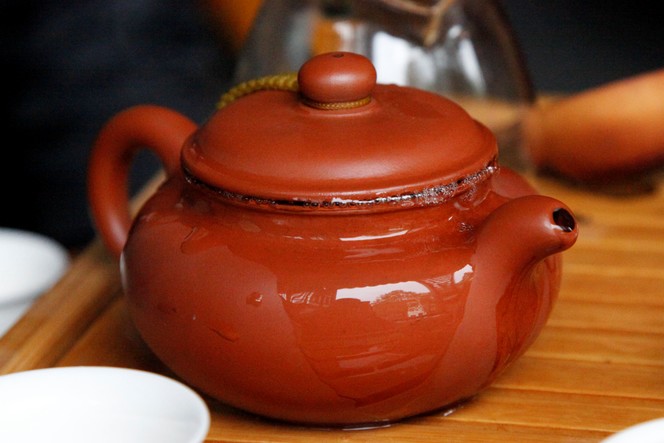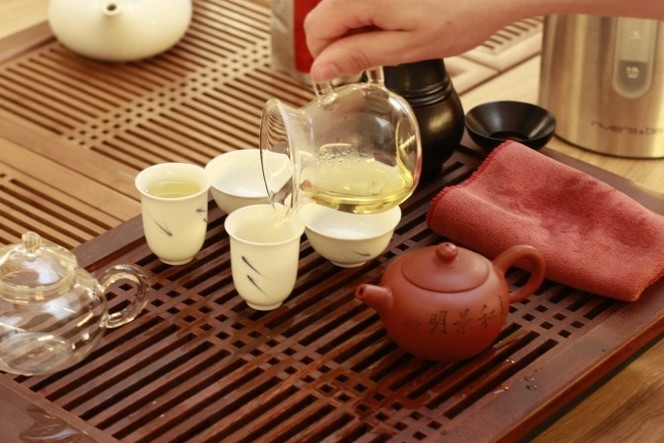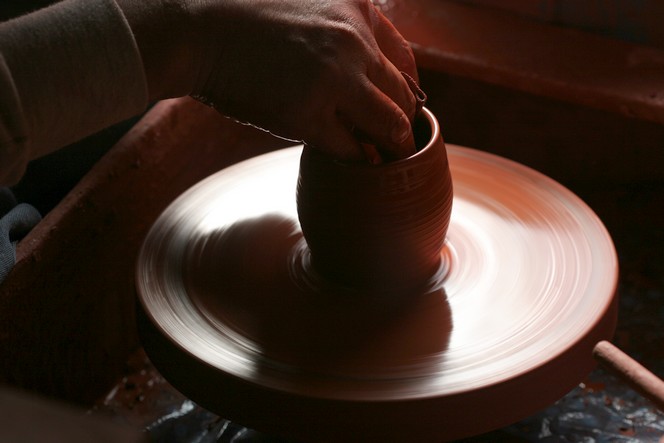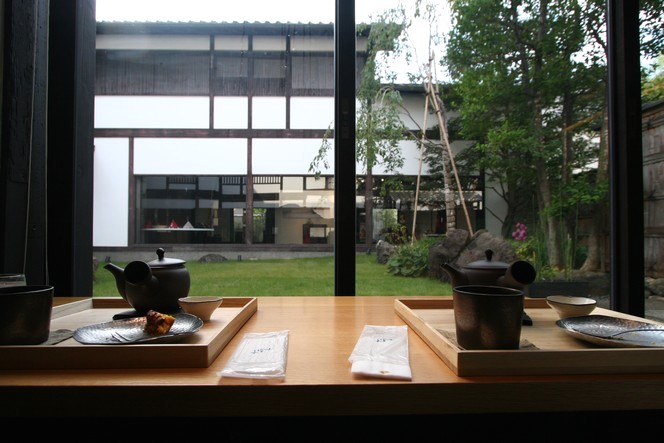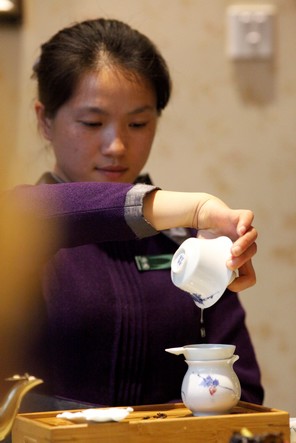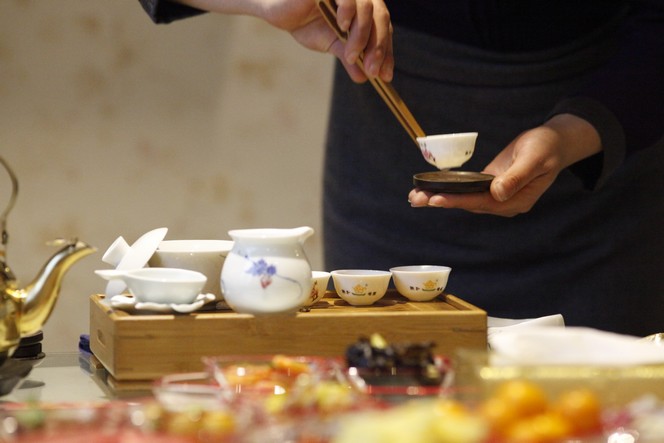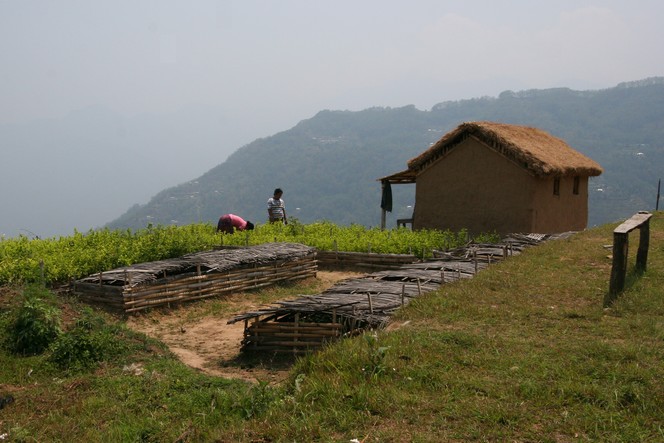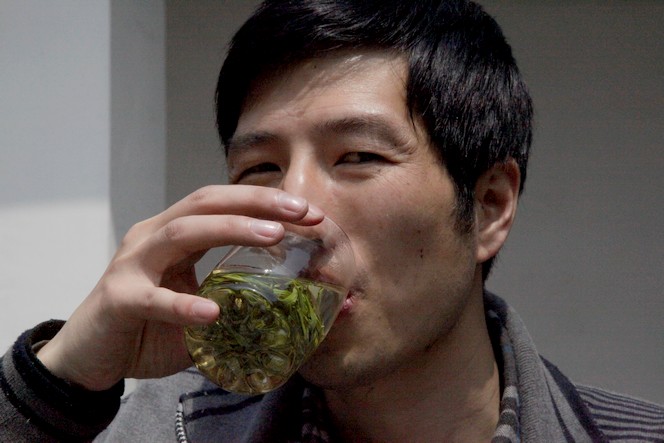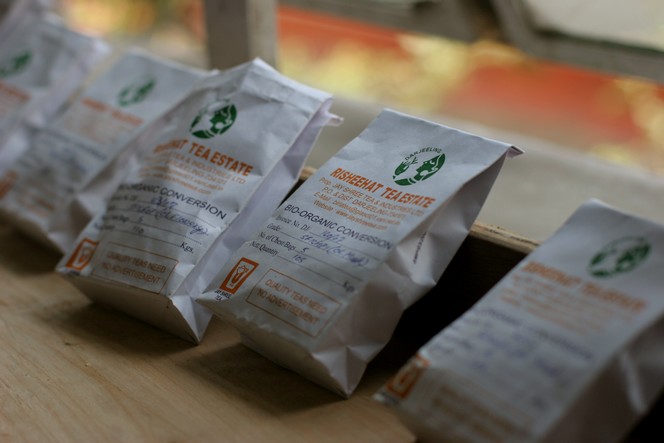When you make tea according to the Gong Fu method, you fill your teapot right to the top, even letting the water spill over to get rid of the scum. Hence the use of the tea boat, the recipient on which the teapot is placed here, which serves as a receptacle.
Tea Tasting
Swapping the kyusu for the tea boat
As I am leaving Japan for China, I am also swapping the “kyusu” for the tea boat. You pour the tea into the first cup, which is quite narrow. You then empty this cup into the wider one. The smelling cup retains the fragrances of the liquor for a long time and allows you to explore the tea’s bouquet. You drink from the second cup, the tasting cup.
Tokoname, a well-known centre of Japanese ceramics
The Japanese city of Tokoname, situated not far from Nagoya, is one of the best known centres of ceramics. The city is home to well-known potters who work in their own studio, which is sometimes part of their house. Many make the famous “kyusus”, the small teapots that can be slightly flat in shape, with a handle perpendicular to the spout. They are used to make the best Gyokuros, or equally delicious Senchas.
The Zen Kashoin tea room in Kyoto
Tradition and modernity come together in Japan. This mix also applies to tea houses. In a city like Kyoto, for example, which is near where I’m staying at the moment, you will find establishments that are more than two hundred years old, which are really worth a detour. Personally, I like the peace and charm of a comfortable place with clean lines like the Zen Kashoin tea rooms, located in the city centre. There, you can enjoy matcha ice-cream and various pastries, accompanied by your favourite green tea.
The “zhong”: two ways of using it well
In China, there are various ways of using the “zhong”. This recipient – also known as a “gaiwan” – can be used as a cup in which the tea infuses. You drink directly from it, retaining the cover and leaving a slight gap to hold back the leaves.
The “zhong” can also be used as a teapot for “gong-fu”, in which several short infusions are prepared. After each one, every last drop of tea is poured into a reserve pot, from which the guests’ tiny cups are filled.
Everyone then gets to taste a tea with particularly concentrated aromas, and to observe the changes in the liquor’s texture and fragrances, infusion after infusion.
How to make tea with delicacy
In China, there are many different ways of drinking tea, as well as a vast array of recipients. The latter range from glass tumblers, which are fairly widespread, to cups made from the finest porcelain. Tea houses have flourished in the country over the past 20 years, and continue to do so. The art of tea is becoming increasingly refined. Great care is taken over the choice of teas to be served, of course, and these are accompanied by some beautiful utensils, like these bamboo tongs which are simply used to pick up a cup.
Tasting new teas is like a bowl of fresh air
While many of you are taking advantage of the long weekend of the Ascension holiday to escape to the country, I’m in Paris at my tasting table with an impressive number of samples before me. I won’t have time to taste them all over the weekend. In Darjeeling, the harvests are over, but I’m now receiving new-season green teas from China, all very fine examples indeed. Every year, their vegetal aroma is like a big bowl of fresh air. I’m also getting sent most of the Nepalese teas which, in nearly a decade, have achieved excellent standards. New gardens are joining them and making themselves known. Excellence is worth waiting for – it has taken them years to reach this point. Just like these young tea plants, which are receiving such attentive care.
Tea can infuse directly in the glass
In China, tea is often infused directly in the glass. As you drink your “cha”, your host tops it up with hot water. To stop the leaves going in your mouth, you bring your teeth together, which doesn’t prevent you from smiling at the same time.
I taste about 50 teas a day
This March I’ve tasted about 50 samples of tea a day. The first flush Darjeelings launch the season, followed swiftly by the Nepalese teas. A little later it’s the turn of the new-season China green teas. Then the Japanese Ichibancha. The teas are tasted blind, of course. The ritual is always the same: having smelt the infusion, you suck in the liquor and swish it around your mouth. You analyse the texture, the flavours, the aroma groups. You take your time. You taste and you taste again. You have to concentrate… Except for when a photographer bursts into the tasting room and captures the moment.
New samples of tea have just been delivered
For the past two days samples of tea have been delivered in large numbers at my tasting room. As soon as they arrive I taste the contents of the little bags on which are marked the name of the garden, the lot number, the grade and the quantity of tea produced.
This is it! In Darjeeling, the season is now properly underway.

